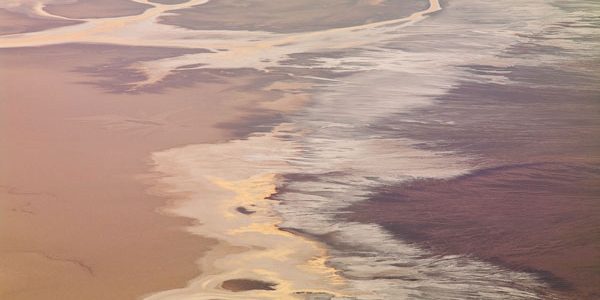Critique Submissions‚ August, 2000
This page contains submissions made during August, 2000 from photographers who wished to have their photographs reviewed by the publisher of this site,Michael Reichmann.For additional details see theCritique / Contestpage.
The August winner of a complimentary 1-year subscription theLuminous Landscape Video JournalwasLeigh Perry.
Leigh Perry‚ August, 2000 Contest Winner
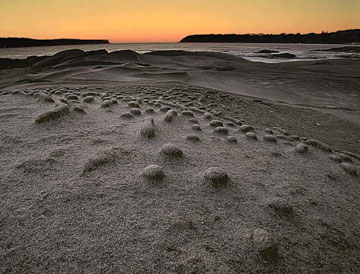
Leigh Perry
Sydney, Australia
Fuji Velvia, Canon 17-35L lens, Canon EOS 50. Exposed 10 seconds at f/22.
Stumbling across these rock erosion leftovers at Balmoral, I liked the way
the foreground rocks appeared almost black and white while the pre-dawn
light in the distance introduced the first colour of the day.
Michael’s Critique
This is a masterful photograph. Technically almost perfect and beautifully realized. Leigh is right, the monochromatic beach contrasted with the breaking light of dawn has a compelling appeal.
The flow of the image is also very interesting and a tension is created. My eye flows from bottom right (foreground) to upper left and then across to the right‚ exploring the curves of the beach below the horizon. I then start all over again. Because of this there is a wonderful tension to the image.
Try an experiment.Right-ClickandCopythe image above and load it into your image processing software. Then flip it horizontally so that it’s a mirror image. What you’ll find is that a completely different feeling is created. Because the eye now scans from left to right‚ the way most Western languages read‚ the tension has been removed. Interesting, isn’t it?
You can add your own comments on Leigh’s photograph on theCritiquesection of ourDiscussion Forum.
Cowan Stark
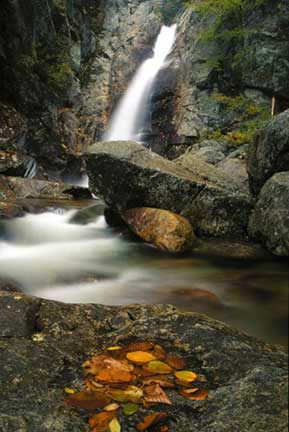
Cowan Stark, from Durham, New Hampshire, USAcowan1@mediaone.net Place: Glen Ellis Falls, New HampshireDate: Early October, 1999Film:VelviaCamera: Canon EOS 3Lens: 24mm tilt shiftScanner: Polaroid SprintScan 4000Exposure: f/22, bracketed like crazy, so I don’t know the shutter speed.Post scan manipulations in Photoshop: +5 Saturation, Unsharp Mask 150/1.5/1.0 New Hampshire in the fall-you have to get up early to beat the crowds. This was taken shortly after sunrise on an overcast day. Glen Ellis Falls is just off rte. 16 near Pinkham Notch. I had to jump over some mossy boulders to get to this side of the river where I found this puddle with leaves. I love the tilt/shift lens, but using it can be fairly demanding and you have to assume all kinds of contortions to get the image composed through the viewfinder especially when lying on cold wet rocks first thing in the morning! The leaves were only inches from the front of the lens, but it’s amazing how much depth field you can get considering it’s not a view camera.
Michael’s Critique
Cowan has submitted a well seen and well realized image this month. What’s not to like? Beautifully composed, sharp from foreground to the top of the falls, and with warm saturated colours. I share Cowan’s passion for the Canon 24mm T/S lens. It’s just about the only 35mm optic that could have made this photograph.
Shooting moving water requires attention to the shutter speed. From the look of the water, the lighting and the aperture used I’d guess that this was taken at at least 1-2 seconds. I tend to like moving water exposed at about 1/8 sec, but often, such as in this example, one deals with all the other variables and then lets the shutter speed fall where it may. Very nicely done Cowan.
You can add your own comments on Cowan’s photograph on theCritiquesection of ourDiscussion Forum.
Chris VenHaus
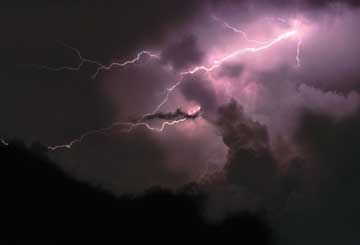
Chris VenHaus
Waukesha WI USA
drmr@execpc.com
Canon A2E
Fuji Velvia
Canon 70-200 f2.8L
My first serious hardcore attempt at lightning photography. I shot 2 rolls over a period of 2 hours as the storm moved through. Most of my time was spent watching the lightning and looking for patterns in the clouds to make for an interesting image. I was unsure about exposure, so I bracketed. Out of the 2 rolls of film, this was the only acceptable image. Most shots were severely underexposed, and the handful that had decent exposures didn’t have quite the right composition. This shot was taken from my back porch with lens at about a 40 degree angle and directly over a street light. The lens was at 200mm. I scanned with a Minolta Dimage Scan Speed scanner and adjusted levels in Photoshop. I have done a bit of dodging and burning to get the image to look more like the slide. I might get a drum scan of this one.
Michael’s Critique
I’ve never been successful at shooting lightning. I enjoy Chris’ photograph but it leaves me somewhat dissatisfied because it lacks context. I want to seewherethis was. Was it in the country or the city? The lack of context removes any possible involvement because there’s no sense of scale.
There is a new product calledLightning Triggerwhich I’ve heard good things about. This is the time of year in North America for lightning photography. Anyone else have a better example?
You can add your own comments on Chris’ photograph on theCritiquesection of ourDiscussion Forum.
Ken Cravillion
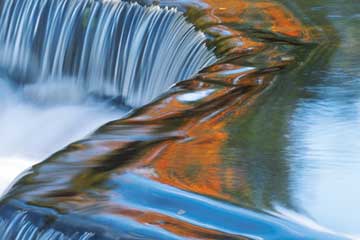
Ken Cravillion
Oshkosh, Wisconsin USA
kenc@execpc.com
Canon EOS-3
70-200 2.8L (80-90mm)
Velvia
Gitzo CF Tripod
Almost as a ritual, I go to Upper Michigan every fall to shoot fall color. This small fall is just up the river from well known Bond Falls.
Michael’s Critique
This is a classic "fall foliage reflected in rushing water"shot. But, Ken’s done a nice job with it. My only criticism is that it feels too constrained. If I could see just a bit more of the waterfall in the lower and upper left I think the image would "breath" a bit. Or, equally as effective, crop it slightly on the right. This makes it tighter and compositionally more satisfying.
This is graphically a strong image‚ essentially an abstract rather than a landscape. I keep looking at it and can almost smell the Fall air and hear the sound of the rushing water. Well done.
You can add your own comments on Ken’s photograph on theCritiquesection of ourDiscussion Forum.
Barry Lobdel
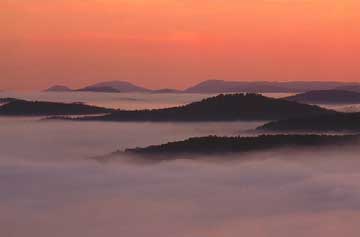
Barry Lobdell, Saranac Lake NY
barry1@adelphia.net This photo was taken just before dawn on an early August morning in the Adirondack Mountains. The view is from the top of Mt. Pisgah, a peak which borders the village of Saranac Lake.
The photograph was taken with a Nikon FA set in manual mode and armed with a 200mm f4 lens. The aperture was set at f8, the speed unrecorded but well bracketed. The film was Velvia. Michael’s Critique
Barry has hit one of my soft spots. Soft pre-dawn light, warm colours, layered silhouetted mountains. Lovely.
This photograph needs a bit of cropping though. There is to much sky and the bottom third of the cloud area is extraneous to the composition.
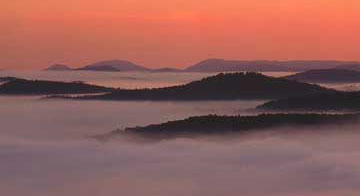
Cropped this way at top and bottom the composition tightens up and the horizontal flow of the hill tops is complimented. A well realized photograph Barry‚ nicely done.
You can add your own comments on Barry’s photograph on theCritiquesection of ourDiscussion Forum.
Ed Leys
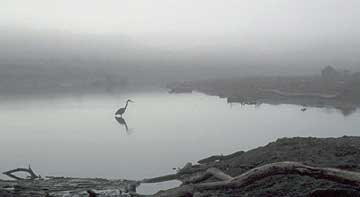
Ed Leys
Milpitas, California
eleys@meer.net
Taken in early morning fog at Cambria, California. Not too many yards from breaking surf; not too many miles from San Simeon.
Nikon FA, Nikon 28~85mm zoom, Fuji Velvia. Other data unrecorded.
Michael’s Critique
A simple, gentle, well-executed photograph. I like the simplicity of the composition as well as monochromatic look.
I’ve played with cropping it just below the bird’s shadow and completely removing the cluttered foreground.
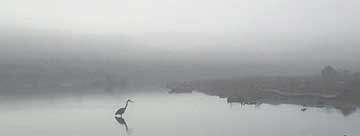
If it were my image, that’s the way I’d present it. But, the way Ed has printed it works as well, giving a more realistic environmental approach.
You can add your own comments on Ed’s photograph on theCritiquesection of ourDiscussion Forum.
John DeMott
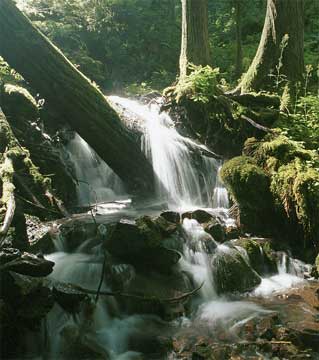
John DeMott
Lake Oswego, Oregon
jdemott@teleport.com
Wahkeena Creek emerges in a torrent from a spring high up on the Oregon side of the Columbia River Gorge, and tumbles about a mile and a half down a steep and rocky canyon before a final, spectacular plunge of several hundred feet into the gorge. This photo was taken last week, about mid-way up the canyon. Morning sunlight was filtering through the high canopy of Douglas firs and western red cedars, creating strong shadows and bright reflections off the water.
I shot with a Nikkor 20mm lens with circular polarizer. An aperture of f/11 yielded a shutter speed of about 1-1/2 seconds, just about right to create a silky texture in the falling water. The film was Gold 100.
Michael’s Critique
It’s hard to resist a waterfall shot. John has done a fine job technically. There’s good shadow detail and the highlights on the water aren’t burned out, which can often be a problem with long exposures of water. I also like the softness of the light in the background as it filters through the trees.
I like the square cropping as well, it adds to the balanced and restful feel of the locale. But I find the left hand side of the frame too messy. I would have moved in closer to the falls, and more to the right‚ emphasizing the waterfall and the right bank.
You can add your own comments on John’s photograph on theCritiquesection of ourDiscussion Forum.
David Muoio
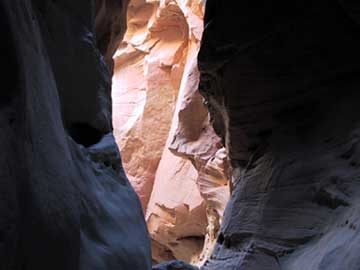
David Muoio
Issaquah, WA
dave@gruntled.com
After having taken a trip the southwest, this photograph is my favorite. The picture was taken in Utah in Round Valley Draw. I’m not a professional. In fact not even close, but I’m curious to know how good or bad this image is to people with a critical eye. The image was taken with a Canon S10 and was mounted on an Ultra Pod tripod strapped to a ski pole. Thus creating a makeshift monopod. I sunk the pole into the dirt and rested the side of the pole against the rock to stabilize it. I then used the timer to avoid moving the camera while depressing the shutter button. Other than setting the resolution and compression values, the picture was taken using default values for exposure compensation/metering, white balance, etc.
Michael’s Critique
The canyonlands of the U.S. southwest are some of the most fascinating areas for landscape photography. David’s photograph succeeds technically but doesn’t do so well artistically. His exposure manages to avoid burned-out highlights but regrettably leaves the shadow areas without much detail. This isn’t necessarily bad, but because the foreground shadow area starts to go out of focus nothing is added by it to the composition.
Cropped to more of a vertical, loosing some of the sides, helps the image somewhat but ultimately it fails to create much interest for me. I feel that while David recorded the scene he wasn’t able to add any individual perspective to it.
You can add your own comments on David’s photograph on theCritiquesection of ourDiscussion Forum.
Jeff Alu
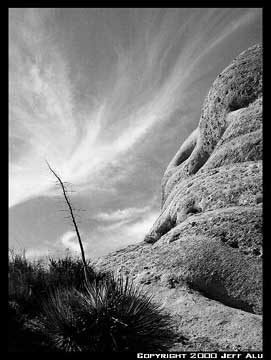
Jeff Alu
http://www.animalu.com/
I shoot almost exclusively in black and white, and I use a digital camera. I’m a 3D Artist/Animator by trade, but love b&w photography because it gets me back to the basics of light and shadow. I began shooting in January, and my subjects are almost always desert landscapes. I enjoy shooting large panoramas but especially zooming way in. I’m using a Kodak DC-280 for capturing images, and doing all processing in Photoshop. Dodging and burning has become a very important part of my work recently.
Michael’s Critique
Back in the 60’s (and certainly at other times as well) there was a "soot and whitewash" school of photography. This eschewed theAnsel Adams / Zone Systemcrowd and strove instead for maximum contrast, even if it meant burned out highlights and blocked up shadows.
Jeff’s photograph, and others on his web site, have a similar feel. The photograph above works because of the bold contrasts of texture and shape. Some images, particularly those with a great deal of detail, can be less successful. It’s a strongly graphic look, and I like it.
On a Technical Note:A very effective way of producing B&W from a colour image (whether from scanned film or directly from a digital camera) is to use theChannel Mixermode inPhotoShopand then selectMonochrome. By adjusting theRGBcolour sliders you can achieve many of the same effects as by using colour filters on-camera when shooting B&W. Just make sure that the three channels combined values add up to roughly 100%.
You can add your own comments on Jeff’s photograph on theCritiquesection of ourDiscussion Forum.
Gene Zonis
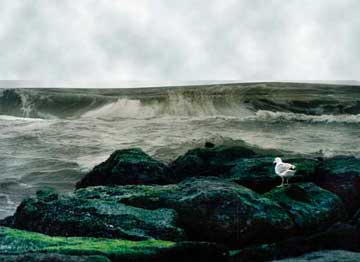
Gene Zonis
Freehold, N.J.
gz@erols.com
Minolta 7000i, Tamron 28-200 Lens, Kodak ASA800 Max Shot on Long Beach Island, N.J.-9/99. One day before hurricane hit Jersey Coast. I wanted to get feel of impeding storm and seagull landed just as I
snapped.
Michael’s Critique
Serendipity is often more important than planning. This moody image is just such an example. The rocks and the crashing waves present a threatening countenance while the sky conveys a lighter mood that’s both jarring yet a perfect offset . The gull, of course, is the needed touch.
You can add your own comments on Gene’s photograph on theCritiquesection of ourDiscussion Forum.
Ian Russell

Photographer: Ian Russell
email address: russell@nets.com.jo
City: Amman
Country: Jordan
Subject: Lodi Tombs, New Delhi, India
Tech. Details: Leica M4-P; 35mm Summicron lens; Ilford Delta 400 film
Scanned on Nikon LS-2000
Michael’s Critique
I find this to be an unsettling photograph, but I like it. There really isn’t a focal point and so my eye keeps wondering, trying to find a place to settle. I don’t know if I could live with it, but I keep coming back and finding mysterious details that raise questions about what I’m seeing.
You can add your own comments on Ian’s photograph on theCritiquesection of ourDiscussion Forum.
Robert Heron
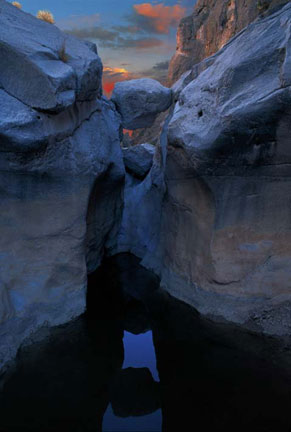
Robert Heron
rbheron@earthlink.net
Denver, CO
The image is a composite. The rock formations are real and do show a metallic sheen. It was taken in Big Bend National Park in Texas. The sky was taken in New Mexico. Used a Nikon Fm2 with a 24mm lens.
Michael’s Critique
This is a stunning image! I’d be proud to have taken it myself‚ if it were real. The composition is excellent and the reflection of the suspended boulder in the water below really makes the shot. I find it too blue but if that’s the way Robert wants it, so be it.
The fact that it’s a composite bothers me though. When I first started with digital image processing I took the position that since photographers have be compositing skies forever (or at least since photography was invented) doing so digitally was no different. I’ve even writtena tutorialon how to improve skies inPhotoShop. I’m now not so sure. It’s a subject that I’m still wrestling with. My sense increasingly is that digital manipulation should be for removal, not addition. It’s a tough topic though, which I discuss in more detail in my essayWhat Photography Isn’t.
You can add your own comments on Robert’s photograph on theCritiquesection of ourDiscussion Forum.
Sherry Bradley
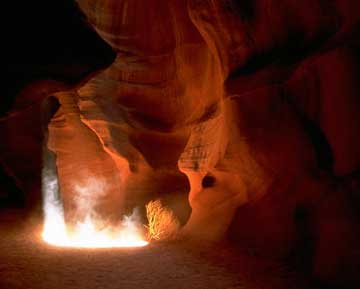
Sherry BradleyDenver, CO
The attached photo was taken in Antelope Canyon in May at about high noon. Conditions were difficult because of over-crowding by admirers and photographers. A stone was thrown in the ray of light, thus creating the cloud of dust. I’m an amateur with training wheels on, with my first camera being a used Nikon M90 body, an Albinar wide-angle lens, and Velvia film. I cropped people out of the photo haven’t further enhanced or treated the image. My tripod was cheap and featureless, limiting the flexibility of shooting more narrow top to bottom views in this slot canyon. (I have since replaced this tripod with a nice SLIK.)Michael’s Critique
Antelope Canyon is one of the icons of contemporary Southwestern landscape photography. I’ve photographedthereand know how difficult it is to produce anything new. Lovely‚ yes; new‚ very difficult. Sherry has done so. This is a stunning photograph. It’s a visual treat and a unique view of a somewhat clichéd locale.
I can’t help but think of a witch’s cauldron or a scene from the underworld when I look at this image. Considering that it was done by a self-confessed beginner using modest equipment should give us all pause. Very nicely done!
You can add your own comments on Sherry’s photograph on theCritiquesection of ourDiscussion Forum.
Dennis J. Begnoche Jr.
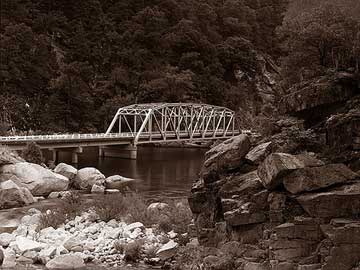
Dennis J. Begnoche Jr.
psart1@email.msn.com
Photo taken in mural class with 4×5 inch Cambo view camera using a Nikkor 210mm lens f32, 25 second exposure. Printed on Ilford matte paper and sepia toned.
Michael’s Critique
Dennis’ photograph is of a type that is typical of a certain school of large-format photography. Tonalities are beautiful, everything is ultra-sharp and a large print is, I’m sure, a pleasure to look at. But, at the risk of being impolite, what’s the point?
This image is strictly a straightforward pictorial representation of a certain place at a certain time. There’s no "life" or feeling beyond its technical excellence. It serves only a documentary record.
Landscape photography has to have emotion. This image unfortunately conveys none tome.
You can add your own comments on Dennis’ photograph on theCritiquesection of ourDiscussion Forum.
John E. Graybill
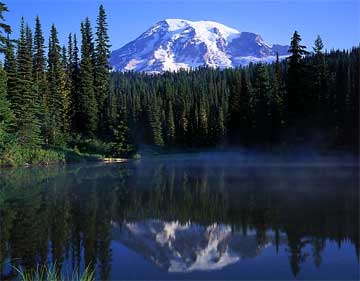
John E. Graybill
Marysville, WA
jgraybill@ix.netcom.com
Shot with an Omega View 4×5, Rodenstock 135 f5.6 (series APO-Sironar-N I
believe, it was a rented lens), Velvia rated at ISO 40, Aug, 9, 2000.
Picture was taken from the smaller of the two lakes at Reflection Lakes, Mount Rainier. I arrived on location about 30 minutes prior to sunrise and waited till I had some light on the tree tops and detail in the mist. I knew the trees would go black without some light on them, I also knew the snow capped mountain was going to be a challenge also and could easily wash out. I took several readings with a Minolta Spot F of the snow and then the deepest dark trees, although I didn’t record the readings I recall a 6+ difference. So, I read the snow and opened up 2.5 stops then I compared that reading to a medium middle tone which I used the blue sky for, they were the same and so that is what I shot it at. Best I can remember it was something like f32 at 1/8.
When I composed the shot I had hoped for a horizontal photo since I feel they look better hanging on a wall that way. However, lining up that way I lost the edge of the bank which might have helped hold the picture together better. I could have done a horizontal lay-up, but that seems best for magazine covers as opposed to art hanging on the wall. Personal preference I guess.
Michael’s Critique
John’s photograph of Mt. Rainier fails to move me. I don’t want to second-guess the situation but it likely would have been a more dramatic image if it had been taken earlier. John says that he waited for the trees to become illuminated. I think this was a mistake as they could have been a strong silhouette while the light was warmer on the mountain.
To be even more picky, the reflection in the lake is blurry, and the grasses in the left foreground is distracting. The mist is potentially interesting but there isn’t enough of it to play an important role in the composition.
As it is the photograph is a "postcard", neither conveying the majesty of the mountain nor the possible drama inherent in early morning mountain light.
You can add your own comments on John’s photograph on theCritiquesection of ourDiscussion Forum.
You May Also Enjoy...
Abstraction Part 1 What is Abstraction
1 - Introduction Today creating images that are unique and that stand out from the work of other photographers is more and more challenging. Locations
